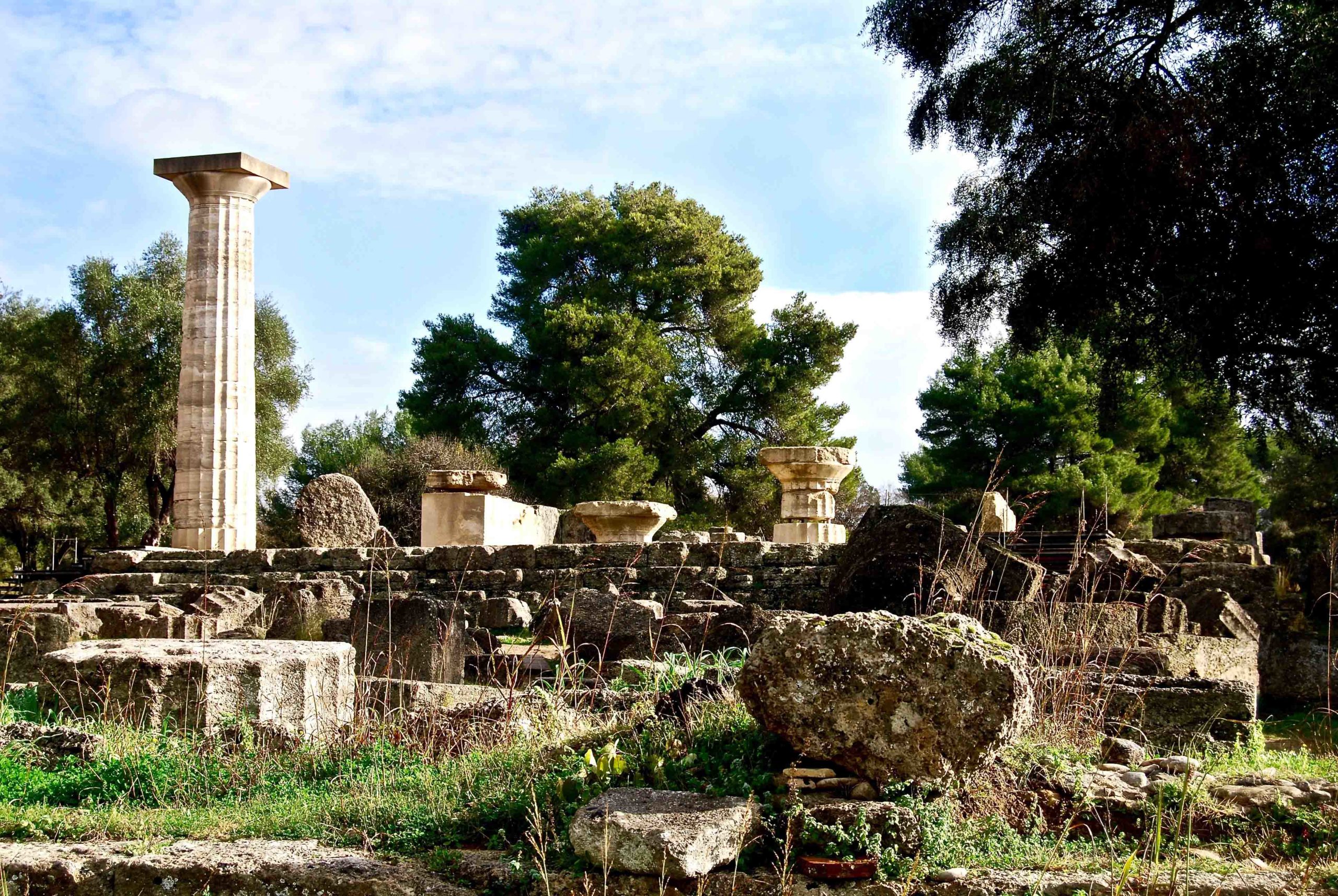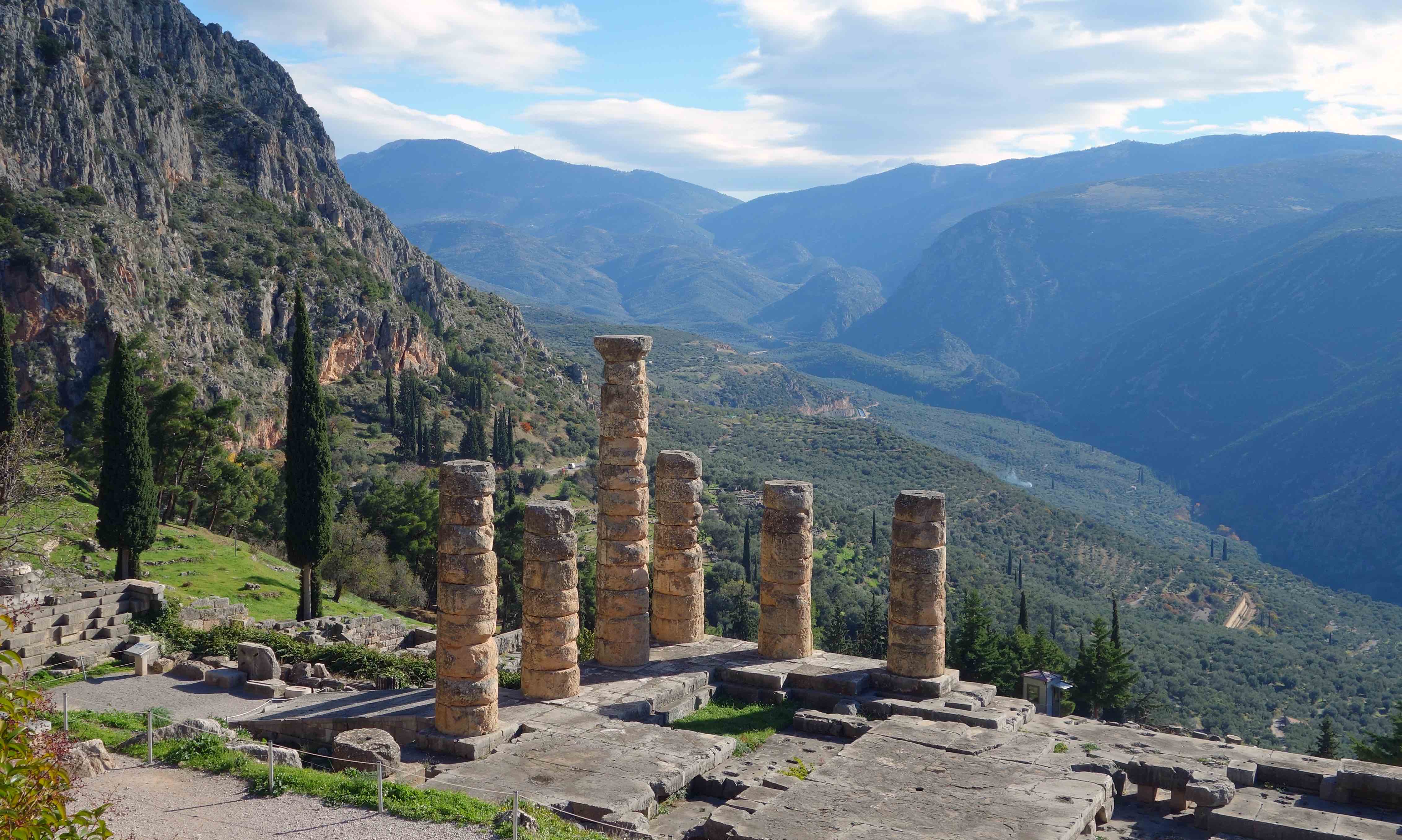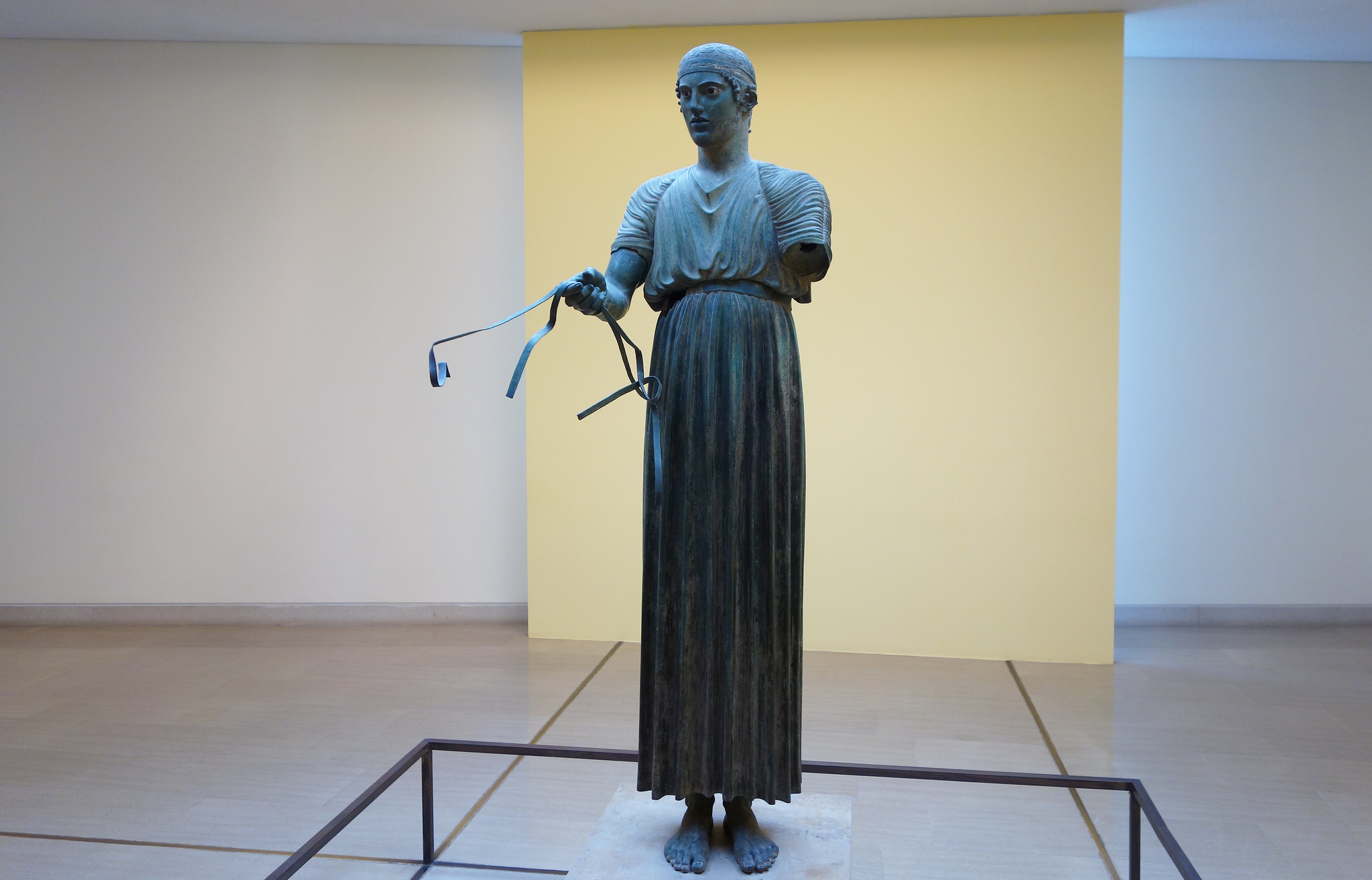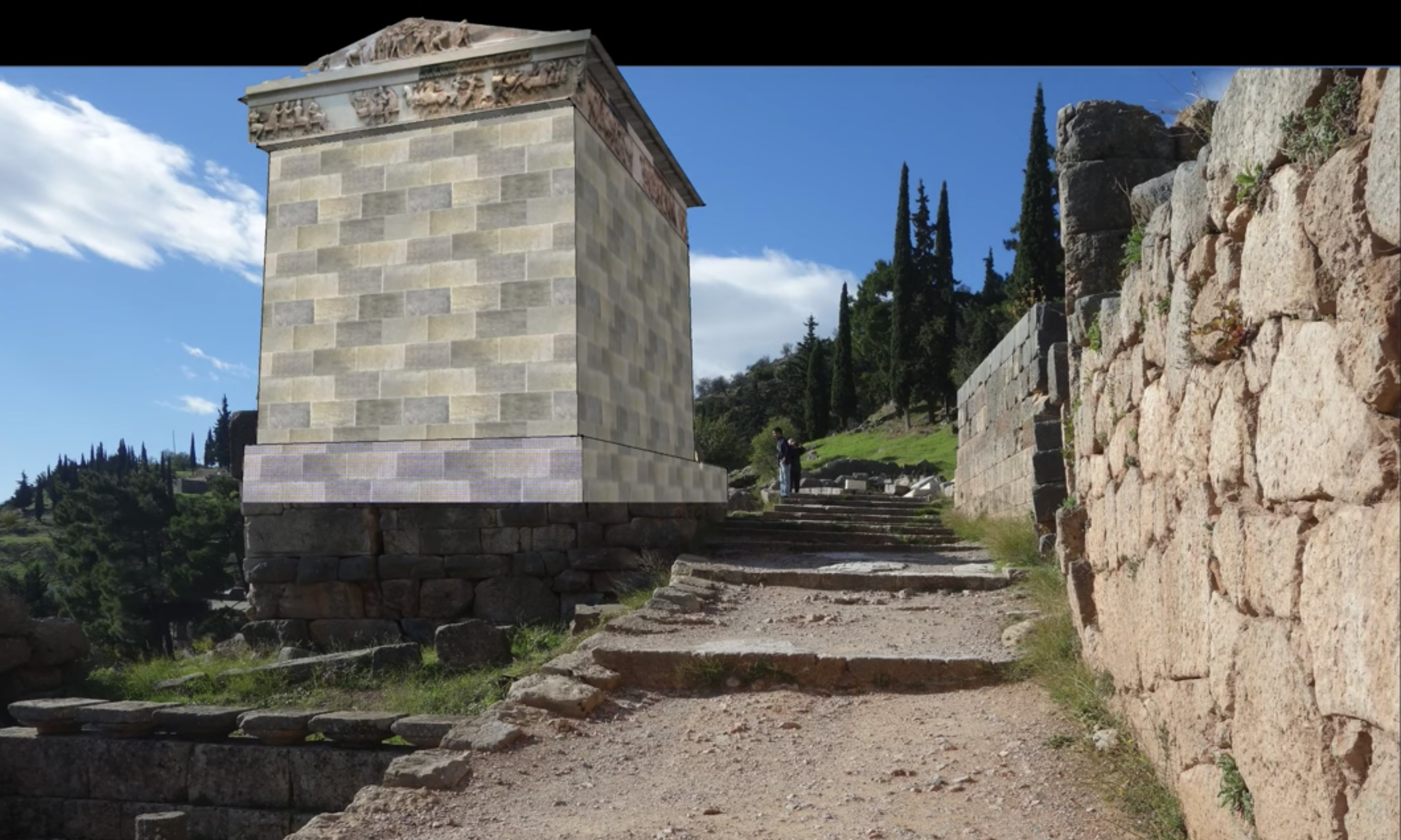2.2 Religion and Philosophy
Greek and Roman Pantheon of Gods
Video from Crash Course URL: https://youtu.be/XNCQ9w59I7M?si=H3EZ-nO3b5WWu38d
Sanctuaries: Art in Service of Gods and State.

Greek religion was polytheistic and firmly embedded in the polis system. Temples were often paid for by the government, and statues of and dedications to the gods were regularly made in civic buildings. Religious festivals were the major holidays in a city’s calendar, and it was expected that all citizens, both male and female, participated in public religious events. Temples served as houses for the gods, with cult statues placed inside which the spirits of the gods could inhabit. In most temples, there was not room for large congregational gatherings inside. Most religious rituals happened outside of the temple. Major festivals would involve public prayers, music, and ritualized movement in processions. The culminating event of the rituals was the sacrifice of animals, which took place on altars, usually placed in front of the entrance of the temple. As the gods received the fat and the bones through burnt offerings on the altars, the meat was left for the worshippers, and feasting would follow sacrifices.
Temples were usually the largest buildings in a city, made of stone—many domestic and civic structures were made of mud brick or timber—and frequently decorated with sculpture and colorful paint. The temples usually followed similar plans and were built using similar designs on their exteriors, like the temples at Paestum.

In addition to civic temples, Greeks also worshiped at sites known as panhellenic sanctuaries. These sanctuaries did not belong to a single polis but to all Greeks (the term “panhellenic” means all Greeks), and provided spaces for Greeks to interact with other Greeks in neutral territory. One such sanctuary was that of Apollo at Delphi. The sanctuary was oracular and people from across the Greek world came to Delphi to ask questions of the priests and priestess (known as the pythia) at the oracle who interpreted the infallible prophecies of Apollo.

In addition to the oracle, there were regular festivals that worshiped Apollo and involved prayers, feasting, and athletic games. Athletes who won at Delphi, like the patron of the Charioteer, dedicated statues in the sanctuary to advertise their win to all future visitors to the sanctuary.

This spirit of competition spread beyond the athletic games, and both individuals and poleis used the sanctuaries to their advertise civic wealth and status to other poleis through dedications of art and architecture. One such example at Delphi is the elaborate Siphnian Treasury, which housed the dedications from the island of Siphnos to Apollo. Panhellenic sanctuaries subsequently became one of the most important spaces for the displays of art and centers for artistic production.
Copyright: Dr. Amanda Herring, “Pottery, the body, and the gods in ancient Greece, c. 800–490 B.C.E.,” in Reframing Art History, Smarthistory, July 21, 2022
Greek Philosophy
Socrates and Plato
As Socrates never wrote anything, he is remembered today because thinkers like Plato featured him in their writings. Plato deliberately dramatized the life of his teacher Socrates. One of the key questions of Plato’s scholarship is exactly how many liberties he took in depicting the life of his teacher. Scholars generally agree that the dialogues that Plato wrote early in his career are more faithful to the life of Socrates than later ones. His writings are usually divided into three periods: early, middle, and late.
The early dialogues feature a skeptical Socrates who refuses to advance any doctrines of his own. Instead, he questions his interlocutors until they despair of finding the truth at all. These early dialogues tend to be somewhat short with a simpler composition. One of the dialogues features a young man named Meno who is the pupil of a prominent Sophist. The dialogue focuses on the nature of virtue and whether virtue can be taught. At one point in the dialogue, Meno famously compares Socrates to a torpedofish, a fish similar to a stingray that paralyzes its prey. Socrates does this to his dialogue partners: they begin the discussion believing that they know something and over the course of the dialogue begin to question whether they know anything at all.
Gradually, Plato has Socrates give voice to more positive doctrines. These include what comes to be known as the theory of the forms, a metaphysical doctrine that holds that every particular thing that exists participates
e invisible realm is eternal, unchanging, and perfect. The material things themselves change, but the immaterial forms remain the same. Consider, for example, the form of a rectangle: four adjacent straight sides that meet at 90-degree angles. You can draw a rectangle, but it is an imperfect representation. The desk or table you are sitting at might be rectangular, but are its edges perfectly straight? How perfect was the instrument that cut the sides? If you nick the edge of a table, then it changes and becomes less like the form of a rectangle. With the doctrine of forms, Plato may be said to combine the metaphysics of Parmenides with that of Heraclitus into a metaphysical dualism.
The philosopher’s task is to access the immaterial realm of the forms and try to convince others of its truth. Plato further believed that if we understand the true nature of virtues like wisdom, justice, and courage, we cannot avoid acting in accordance with them. Hence, rulers of states should be philosopher-kings who have the clearest understanding of forms. Yet philosopher-kings never have perfect knowledge because our understanding is based on a material realm that is always changing. True knowledge is only possible in the abstract realms, such as math and ethics.
In the dialogues, Socrates claims that he was divinely inspired to question prominent citizens of Athens to determine whether their claims to know could be verified. These citizens grow annoyed with Socrates after some years of this treatment, eventually bringing charges against him for corrupting the youth and making the weaker argument appear the stronger. The proceedings of the resulting trial were immortalized in Plato’s Apologia, where Socrates presents his defense of his life’s work as a philosopher. The dialogue’s name derives from the Greek apologia, meaning “defense”—Socrates never apologizes for anything! He is found guilty and sentenced to death. Socrates becomes a martyr to philosophy, put to death by the democratic government of Athens.
Read and English translation of Plato’s “Allegory of the Cave” from The Republic, Book VII, 514a-521d)
Aristotle
During the Middle Ages, people referred to Plato’s most famous pupil Aristotle as simply “the Philosopher.” This nickname is a testament to his enduring fame, as well as to the fact that he was driven by philosophical curiosity to try to understand everything under the sun. The first sentence of his famous work Metaphysics states, “Philosophy begins in wonder.” He exemplified this claim in his writing. His works ranged widely across all the main areas of philosophy, including logic, metaphysics, and ethics. In addition, he investigated natural philosophy, the fields of study that eventually gave rise to science. Aristotle also researched topics that would today be classified as biology and physics. Stylistically, his work was very different from that of his teacher. While Plato’s work was literary and even dramatic, Aristotle’s writings are presented as lecture.
Plato and his successors were prone to mysticism. It was easy to translate the philosophical theory of the forms into a mystical doctrine in which the forms were known by the mind of God. Aristotle resisted this trend. At the center of Aristotle’s work was his doctrine of the four causes. He believed that the nature of any single thing could be understood by answering four basic questions: “What’s it made of?” (material cause), “What shape does it have?” (formal cause), “What agent gave it this form?” (efficient cause), and, finally, “What is its end goal?” (final cause). Not only can we explain the nature of anything by answering these four basic questions, but we can also understand the nature of the universe. Aristotle’s universe is a closed system that is comprehensible to humanity because it is composed of these four causes. Each cause leads to another, until we get to the first cause or prime mover at the head of it all. Somewhat obscurely, Aristotle claims that this first cause is “thought thinking itself.”
In addition to the doctrine of the four causes, it is important to understand Aristotle’s account of the soul. Unlike Plato, who held that the soul is an eternal substance that is reborn in various bodies, Aristotle has a functional conception of the soul. He defined the soul based upon what the soul does. In Aristotle’s understanding, all living things have souls. Plants have a vegetative soul that promotes growth and the exchange of nutrients. The animal soul, in addition to taking in nutrients and growing, experiences the world, desires things, and can move of its own volition. Added to these various functions in humans is the ability to reason.
With the four causes and the functional conception of the soul, we can begin to understand Aristotle’s ethics. Aristotle systematized Plato’s conception of ethics based upon his conception of the self and his four causes. Since everything that exists has a purpose, one of the basic questions for ethics is “What is the purpose of the human being?” After considering such candidates as pleasure and power, Aristotle settles on the answer “happiness” or, more accurately, “eudaimonia.” Rather than a fleeting emotional state, eudaimonia is better understood as “flourishing.” So the question at the heart of Aristotle’s ethics is “How should humans best achieve happiness?” His basic answer is that we achieve eudaimonia by cultivating the virtues. Virtues are habits of character that help us to decide what action is preferable in a particular moment. Cultivating these virtues will helps us to lead a fulfilling life.
It is generally true to say that Plato tended to be more focused on the transcendental world of the forms while Aristotle and his followers were more focused on this worldly existence. They shared a belief that the universe was comprehensible and that reason should serve as a guide to ordering our lives.
Epicureans
In the wake of the giants of Greek philosophy—Socrates, Plato, and Aristotle—some philosophers turned away from Plato’s ideal forms and toward materialism. In this, they can be seen as furthering a trend already present in the thinking of Aristotle. For Aristotle, there can be no immaterial forms—everything that exists has some material basis, though he allows an exception for his first cause, the unmoved mover.
The Epicureans steadfastly rejected the existence of immaterial forms, unmoved movers, and immaterial souls. The Epicureans, like Aristotle, embraced empiricism, which means that they believed that all knowledge was derived from sense experience. This view was the basis of the revival of empiricism in 18th-century British thought and scientific practice. They espoused an ethical naturalism that held that in order to live a good life we must properly understand human nature. The ultimate goal of life is to pursue pleasure. Despite their disagreements with Plato and, to a lesser extent, Aristotle, the Epicureans agreed with their predecessors that human existence ought to be guided by reason.
The two principal Greek Epicureans were Epicurus himself (341–270 BCE) and his Roman disciple Lucretius (c. 99–55 BCE). Although Epicurus’s views are characterized as hedonistic, this does not mean that he believed that we ought to be indiscriminate pleasure-seekers. Instead, he proposed that people could achieve fulfilling lives if they were self-sufficient and lived free from pain and fear. Of course, complete self-sufficiency is just as impossible as a life utterly free from pain and fear, but Epicurus believed that we should strive to minimize our dependence upon others while limiting the pain in our lives. Epicureans thought that the best way to do this was to retire from society into philosophical communities far from the hustle and bustle of the crowd. Epicurus and Lucretius saw the fear of death as our most debilitating fear, and they argued that we must overcome this fear if we were going to live happy lives.
Lucretius developed Epicurean philosophy in a poem called De Rerum Natura (On the nature of things). This poem discusses ethical ideas, but physics provides its focus. Lucretius adopts a material atomism that holds that things are composed of atoms in motion. Rejecting religious explanations, he argues that the universe is governed by chance and exemplified by these atoms in motion. Although the Epicurean philosophers were critically responding to the work of Plato and Aristotle, it should be evident that they also have antecedents in Presocratic thought. We can see this in their atomism and their religious skepticism, which hearkens back to Xenophanes.

